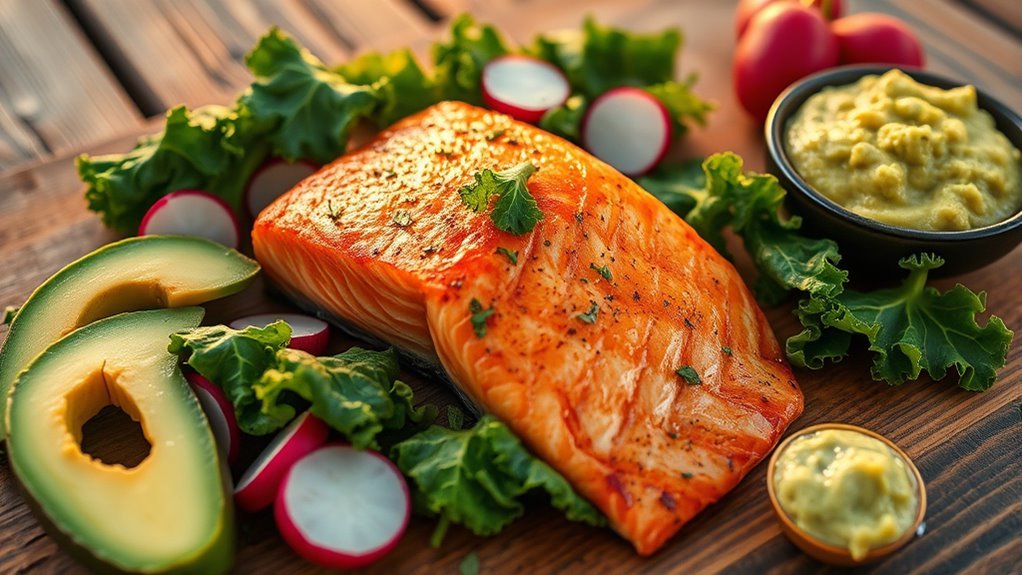The ketogenic diet, or keto, is a low-carb, high-fat eating plan that shifts your body’s metabolism from burning carbs to fats, inducing a state called ketosis. This process can lead to improved energy levels, weight loss, and mental clarity. You’ll typically consume 70-75% fats, 20-25% proteins, and only 5-10% carbohydrates. While there are benefits, you might also face challenges during your keto journey. There’s much more to explore about the diet and how to make it work for you.
Understanding the Ketogenic Diet

When it comes to understanding the ketogenic diet, it’s essential to grasp its fundamental principles. At its core, the diet focuses on drastically reducing carbohydrate intake, which leads your body into a state of ketosis. This metabolic state allows your body to burn fat for energy instead of carbs, revealing numerous ketosis benefits like improved energy levels, mental clarity, and weight loss. Some individuals explore carb cycling, where they alternate between high and low-carb days to optimize performance and maintain metabolic flexibility. This approach can help you enjoy the benefits of ketosis while still indulging in carbs occasionally. By understanding these concepts, you can take control of your dietary choices and enjoy the freedom to customize your nutrition plan.
How Keto Works: The Science Behind It

Although the ketogenic diet is often associated with rapid weight loss and increased energy, its effectiveness stems from a specific biochemical process called ketosis. When you drastically reduce carbohydrate intake, your body shifts into a keto metabolism, relying on fat for fuel instead of glucose. This process lowers your insulin response, promoting fat adaptation and helping to stabilize energy levels. As your body becomes more efficient at utilizing fats, you may experience improved brain function and hormonal balance. Nutrient absorption also plays a role, as the keto diet emphasizes whole, nutrient-dense foods. Overall, this shift can lead to significant weight loss while enhancing physical and mental well-being, giving you the freedom to feel your best.
Key Components of a Keto Diet

When you start a keto diet, understanding macronutrient ratios is essential for achieving ketosis. You’ll want to focus on incorporating specific foods that align with these ratios, emphasizing high fats, moderate proteins, and very low carbohydrates. This balanced approach helps guarantee you’re fueling your body effectively while adhering to the principles of the diet.
Macronutrient Ratios Explained
Macronutrient ratios are the backbone of a successful ketogenic diet, guiding you in achieving and maintaining a state of ketosis. For ideal macronutrient balance, aim for about 70-75% of your calories from healthy fat sources, 20-25% from protein intake, and only 5-10% from carbohydrates. Carb counting becomes essential here, as it helps you make necessary dietary adjustments while focusing on nutrient density. Pay attention to meal timing and food quality, as these factors can influence your health goals. Consider your lifestyle factors, like activity level, when determining your macronutrient needs. This individualized approach guarantees you enjoy the freedom of a keto lifestyle while staying aligned with your personal wellness objectives.
Foods to Incorporate
To successfully navigate a ketogenic diet, it’s crucial to focus on incorporating specific foods that align with your macronutrient goals. Prioritizing the right ingredients will make your keto journey enjoyable and sustainable.
- Healthy fats: Avocados, olive oil, and coconut oil are great sources.
- Protein sources: Consider grass-fed meats, eggs, and fish to meet your needs.
- Low carb vegetables: Spinach, broccoli, and zucchini can add essential nutrients without the carbs.
In addition, don’t overlook keto snacks like cheese and nuts, dairy options for creaminess, and sugar substitutes for sweetness. Meal replacements and keto-friendly fruits can also play a role. Stock up on these pantry staples to guarantee versatility and flavor while staying true to your keto lifestyle.
Potential Health Benefits of Keto
While many people turn to the ketogenic diet for weight loss, its potential health benefits extend beyond just shedding pounds. You might experience improved blood sugar regulation, which can be particularly beneficial for those with insulin sensitivity. Many report enhanced mental clarity and increased energy levels, making daily tasks feel more manageable. The diet may support heart health by promoting healthier cholesterol levels and reducing inflammation. Additionally, some athletes find that keto boosts their performance by providing a steady energy source. It can also improve digestive health and help maintain hormonal balance. Ultimately, the longevity benefits associated with a ketogenic lifestyle could contribute to a healthier, more vibrant life. Embracing keto may empower you to take control of your well-being.
Common Challenges and Side Effects
Although the ketogenic diet offers numerous benefits, many people encounter common challenges and side effects as they shift to this low-carb lifestyle. You might experience:
- Keto flu: Initial fatigue, headaches, and irritability as your body adapts.
- Electrolyte imbalance: Low-carb diets can lead to dehydration and imbalances in minerals like sodium and potassium.
- Digestive issues: Changes in fiber intake can result in constipation or bloating.
Managing cravings can be tricky, especially in social situations, and meal boredom may set in over time. Long-term sustainability can also lead to nutrient deficiencies if not carefully planned. You may hit weight loss plateaus or experience mental fog, making it essential to stay informed and adjust as needed. Remember, understanding these challenges can empower your journey.
Keto Meal Planning and Food Choices
When you’re planning your keto meals, focusing on essential foods is key to staying within your carb limits while maximizing nutrition. Incorporating meal prep tips can save you time and help you stick to your diet, making it easier to choose the right options throughout the week. By exploring weekly menu ideas, you can create a balanced approach that keeps your meals exciting and aligned with your keto goals.
Essential Keto Foods
To successfully navigate the ketogenic diet, it’s essential to choose the right foods that align with its low-carb, high-fat principles. Focusing on essential fats and nutrient-dense options keeps you satisfied and energized while promoting ketosis. Here are some must-have keto foods:
- Avocados: Packed with healthy fats and fiber, they’re perfect for snacking or adding creaminess to dishes.
- Nuts and seeds: Great keto snacks that provide protein, healthy fats, and important minerals.
- Fatty fish: Salmon and mackerel are rich in omega-3 fatty acids, vital for overall health and wellness.
Meal Prep Tips
Choosing the right foods is just the beginning of your keto journey; meal prep can greatly enhance your success. By organizing your meals in advance, you’ll save time and guarantee you stick to your keto goals. Start with a solid grocery list, focusing on quality ingredients for flavor enhancement. Consider batch cooking to create keto snacks and main dishes that can be stored in meal containers for easy access.
| Meal Prep Tips | Benefits |
|---|---|
| Recipe Organization | Streamlines cooking |
| Portion Control | Prevents overeating |
| Storage Solutions | Keeps food fresh |
| Ingredient Substitutions | Maintains flavor |
With effective time management and these strategies, you’ll enjoy the freedom of a well-prepared keto lifestyle.
Weekly Menu Ideas
Planning a weekly keto menu can make all the difference in staying on track with your dietary goals. With a bit of preparation, you can enjoy delicious meals while keeping your carb intake low. Here are some ideas to get you started:
- Keto breakfast ideas: Spinach and cheese omelet or Greek yogurt with nuts.
- Keto lunch recipes: Zucchini noodles with marinara or a chicken salad with avocado.
- Keto dinner suggestions: Grilled salmon with asparagus or a hearty cauliflower casserole.
Don’t forget to include keto snack options, like cheese cubes or mixed nuts. Make a keto grocery list to streamline shopping while sticking to portion sizes. This approach can help you embrace keto on a budget and enjoy tasty family meals without feeling deprived.
Variations of the Ketogenic Diet
As you explore the world of ketogenic diets, you’ll find several variations tailored to different health goals and lifestyles. The Standard Keto is a classic choice, while High Protein Keto emphasizes more protein intake. If you’re looking for flexibility, Cyclical Keto allows you to alternate between low and high-carb days. Targeted Keto lets you consume carbs around workouts for energy. For plant-based eaters, Vegetarian and Vegan Keto offer suitable options. If you prefer a more relaxed approach, Lazy Keto focuses on keeping carb counts low without strict meal planning. Dirty Keto allows for processed foods, while Mediterranean Keto emphasizes whole foods. Finally, Bulletproof Keto incorporates high-quality fats for ideal brain function. Explore these variations and find what resonates with you!
Who Should Consider Going Keto?
Wondering if the ketogenic diet is right for you? Here are some factors to take into account:
- Health considerations: Those with certain medical conditions, like epilepsy or type 2 diabetes, might benefit from keto.
- Personal goals: If you’re aiming for weight management or improved athletic performance, keto could align with your objectives.
- Lifestyle factors: If your dietary preferences lean towards low-carb foods, keto might be a natural fit.
Age demographics also play a role; younger individuals may find it easier to adapt. However, reflect on long-term sustainability and mental clarity. Make certain your choice aligns with your lifestyle and personal goals. Always consult a healthcare professional to guarantee the diet supports your overall health.
Tips for Success on a Keto Journey
To succeed on your keto journey, it’s essential to understand the key principles of the diet and how they can fit into your daily life. Start by planning your meals; this helps you stay on track and reduces the chances of impulsive eating. Utilize keto motivation strategies, like setting achievable goals and tracking your progress, to keep your enthusiasm alive. When cravings hit, focus on overcoming them by having keto-friendly snacks on hand or engaging in activities to distract yourself. Remember, flexibility is key—allow yourself occasional treats to maintain balance. Surround yourself with a supportive community to share experiences and tips. Embrace the freedom of this lifestyle, and you’ll find success on your keto journey.


